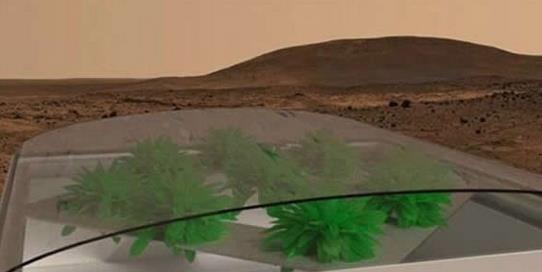SciShow is supported by Blue Apron.
《太空科学秀》由送餐服务(Blue Apron)赞助播出。
Right now, Blue Apron is offering $50 off two boxes of meals to the first 50 SciShow Space viewers to sign up.
现在,送餐服务为前50名注册《太空科学秀》的观众提供头两餐50%减免。
Get fresh ingredients and chef-designed recipes delivered right to your door.
动动手指即可让新鲜的食材和大厨定制的菜谱送到嘴边哦!
Just click on the link in the description to get $50 off your first two Blue Apron boxes.
大家只需要点击介绍中的链接,即可获得头两餐50%的减免。

These days, it seems like we're closer than ever to transporting humans around the solar system.
最近,似乎将人类送到太阳系里的梦想唾手可得了。
But getting people into space is one thing; keeping them alive is a whole different ball game.
但将人送到太空是一回事,保证人的生命安全却是另一回事了。
It's the difference between exciting new exploration and just a really expensive way to die.
做的好就是一次激动人心的全新探险,做的不好就是砸钱送死。
Among a bunch of other things, one of the most important elements to sustaining life beyond Earth is making sure we're really well fed.
在太空中维持生命有很多要素,其中一个最为重要的要素就是饿不着肚子。
So far, a lot of thinking has gone into ways to grow food in places like the Moon or Mars, but those are just single locations in the vast solar system.
目前为止,大家的思路还是集中于在月球或者火星上种食物,但月球和火星也不过是广阔太阳系里的沧海一粟而已。
What we really need is a cosmic food court capable of feeding us wherever we go.
我们需要的是随处可见的宇宙小吃一条街。
And for that, we might want to look to the asteroid belt!
这样的话,我们可能就要指望小行星带了!
All this concern about growing food is necessary because of our pesky friend gravity.
我们对种食物是否成功的担心是有必要的,因为有这么一个东西叫重力。
It takes a ton of energy to escape the Earth's gravitational pull, and even with reusable rockets, getting to space can be pretty pricey.
脱离地球引力需要耗费很多能量,即便动用可重复利用的火箭,进入太空的成本也十分高昂。
Take SpaceX's new Falcon Heavy rocket, for instance.
就拿太空探索技术公司新的猎鹰重型运载火箭为例。
It's among the most efficient rockets today, but pack it full of food for Mars and you'd be paying more than $5,000 per kilogram.
猎鹰重型运载火箭是当今效率最高的火箭,但要让它携带食物到太空,成本高达每公斤5000多美元。
For a one-off trip, maybe that makes sense, but to settle humans on Mars it would cost $5,000 per kilogram per person, for the rest of their lives.
要是一次性能做完,还可以考虑,但要将人类都送上火星的话,每个人每公斤高达5000美元。
That's just not sustainable.
这样做不长久。
Conveniently, though, it turns out we've solved this problem before, like a lot, — and with something really simple: seeds.
不过,我们后来用很方便的方法从很大程度上解决了这个问题——很简单,就是用种子。
One obvious example is when Europeans crossed the Atlantic to settle in North America, they didn't bring a lifetime's worth of food with them.
有个信手拈来的例子:欧洲人穿越大西洋在北美洲定居的时候,并没有带够粮食。
Instead, they brought the means to create more food once they got there. They farmed.
不过,他们为当地带来了创造更多粮食的方法——农耕。
In that example, North America already had people who were farming, but it's still a good tactic for getting food to space!
虽然当时北美洲已经有人在务农了,但将食物带到太空去不失为一个好的策略。
Once we figure a few things out, this could work for a place like Mars, where settlers could grow food right on the surface.
我们只需要解决几个问题,就能将火星这样的地方为我们所用——在其表面种粮食。
But if we sent people to Jupiter's moon Europa or Saturn's moon Titan, things would get more complicated.
但如果要把人类送往木星的木卫二或者土星的土卫六上,事情就会更加复杂了。
Those trips would last for years, and because of their surface conditions, there'd be nowhere to farm right when we got there.
光是送到木卫二或者土卫六上就要花费多年时间,而且由于星球表面环境的限制,即便送上去了,也没法耕作。
That's where asteroids come in.
这就是小行星大展身手的时候啦。
Since they mostly orbit between Mars and Jupiter, they could be a convenient gateway to the outer solar system.
鉴于小行星一般都是在火星和木星之间飞行,所以去外太阳系一定有方便的途径。
They're also a lot smaller than even the Moon, meaning they have dramatically less gravity to escape, which would greatly reduce the food's cost to ship.
小行星比月球还要小很多,也就是说,小行星逃逸出去需要摆脱的引力要小很多,这样的话,运载粮食的成本也就小了很多。
Ceres, which is often considered the largest asteroid, has about 3% of Earth's surface gravity, and most others have thousands of times less than that.
一般认为,谷神星是最大的小行星,其所受引力是地球表面引力的3%,其他小行星所受引力比谷神星要还要小很多。
Most importantly, though, some kinds of asteroids may already contain many of the most important nutrients for life.
不过,最重要的是,一些类型的小行星可能已经具备了支持生命最重要的营养成分了。
They're called carbonaceous asteroids, or sometimes C-types.
这种小行星被称为碳粒小行星,即C型小行星。
C-types are probably the most common kind of asteroid, but they're remarkably difficult to study because of their appearance.
C型小行星很可能是最为常见的一种小行星了,但研究这类小行星的难度很高,这是因为它们的外形。
They reflect just a tiny percentage of the Sun's light, and probably look more like coal than whatever you're picturing right now.
C型小行星只会反射一小部分太阳光,外形与煤炭极为相似。
I say probably because we haven't really been able to study carbonaceous asteroids in great detail.
我之所以没有笃定的说,是因为我们还没有深入研究这类小行星。
Instead, most of what we think we know about them comes from meteorites called carbonaceous chondrites, which are likely chips of C-type asteroids.
我们对这类小行星的大部分认知都来自于碳质球粒陨石,碳质球粒陨石就像C型小行星的芯片一样。
Based on the name, you might think they're mostly made of carbon.
只看名字的话,大家可能会认为碳质球粒陨石大部分是由碳组成的。
But they only contain a small percentage of carbon at best, along with nitrogen, potassium, and phosphorus.
但其实他们最多只含有少量碳,此外还有氮、钾、磷。
Sounds like fertilizer, doesn't it?
听起来很像肥料,是吧?
Amazingly, deep inside these meteorites, we've also found evidence of some of the same amino acids that are inside our bodies, as well as other organic compounds.
令人惊讶的是,在碳质球粒陨石里,我们还发现其中的一些氨基酸等有机化合物与人体里的一模一样。
To top it all off, some carbonaceous chondrites contain up to 20% of their weight in water.
此外,一些碳质球粒陨石里的水分占重量的20%。
Some of that was surely absorbed here on Earth, but many meteorites contain evidence suggesting they formed in the presence of liquid water, too.
其中一些水分肯定被地球吸收了,但很多陨石中的线索都表明它们形成过程中有水的存在。
These useful elements were even enough for one chemist to grow plants in crushed up meteorites!
这些元素很有用,就算让化学家在搅碎的陨石里种植物也够了。
But hold your space tractors, because we're not ready to start farming just yet.
不过先别急,我们还没准备现在就开始种植。
Ironically, the main obstacle to growing plants on an asteroid might be one of its main benefits: microgravity.
讽刺的是,在小行星上种植物的主要障碍可能也是其中一个优势:微重力。
Space station and Space Shuttle experiments going back decades have tried to grow plants in zero-g with only limited success.
过去几十年来,空间站和航天飞机曾实验过多次,想要在零重力的环境下种植物,但鲜少成功。
Even though the plants often grow well, the seeds they produce rarely create a healthy second generation.
即便植物长得不错,他们生出来的种子也很少有能产生健康下一代的。
Which is obviously key, if you're looking to set up a long-term farming operation.
如果想要实现长期农耕,这就成了瓶颈。
But some recent experiments are finding more success, so it's not all bad news.
不过,最近的一些实验也取得了成功,所以并不都是坏消息。
And, of course, we'd still need to provide the right atmosphere, enough sunlight, and protection from cosmic radiation, so this is an idea for the long haul.
当然了,我们还需要提供合适的环境、足够的日照、对宇宙辐射的防护,所以长远来看,这也不失为一个办法。
But if we can get it right, the dividend could be awesome, in the true sense of the word.
但如果我们能做好这件事,会对人类大有裨益。
One estimate suggests that the total population of C-type asteroids could sustain a billion humans for the rest of the Sun's lifetime -- no matter where they are.
有估测认为,所有C型小行星加在一起可以在太阳生命终结前支持10亿人的生命——无论身在何处,都可以。
Fortunately, we're also about to reach an important milestone in all of this.
幸运的是,在这项工作中,我门也即将抵达一个重要的里程碑。
This summer, Japan's Hayabusa2 spacecraft will reach the asteroid Ryugu, marking the first time we can properly study a C-type asteroid up close.
今年夏天,日本隼鸟2号宇宙飞船将抵达龙宫,这意味着我们可以第一次近距离研究C型小行星了。
What's more, Hayabusa2 will also scoop up a piece of its surface and return the sample to Earth by late 2020.
更重要的是,隼鸟2号还会在2020年末之前,将其表面的一部分样本带回地球进行分析。
So, who knows? Maybe that could start the clock towards a future fed by asteroids.
所以,谁也不能把话说死。或许隼鸟2号能让小行星供养人类未来的生活。
Thanks to Blue Apron for sponsoring this video.
感谢收看本期由送餐服务赞助的节目。
And for giving me the confidence to cook pork chops for the first time!
也感谢大家让我第一次有了做牛排的信心。
I did not grow up in a cooking house, so even though I like to try new foods, I don't know how to bring them into being in my kitchen.
我们家人都不是很会做饭,所以虽然我很乐于尝试做新的菜式,但我不知道怎样落实到自己的厨房里。
And it's a problem because my boyfriend is a really good cook and he'll ask me to help him season things and I just panic and put a ton of cumin in EVERYTHING.
这对我而言是个困扰,因为我男朋友很会做饭,而且他会让我帮他放作料,但我因为太害怕,总是放的太多……
But the other night I made pork chops with quick pickled cabbage and potato salad with buttermilk dressing.
但前几天晚上,我做了猪排搭快手泡菜,还做了奶酪土豆沙拉。
Blue Apron recipes are super straightforward and explain everything, so you're learning to cook while making a really good meal.
送餐服务的菜谱清晰易懂,所以可以边看边做。
And, if you get nervous in the kitchen, like I do, it's really comforting to have those step-by-step instructions.
如果大家像我一样,一下厨就紧张的话,有这种一步一步讲解的小助手会轻松许多。
I didn't overthink, or over season, anything, and it turned out delicious.
我不会过度曲解,也不会加多作料,做出来的菜也很美味啦!
So to build your own confidence in the kitchen, check out Blue Apron at the link in the description.
所以要树立主厨信心的话,可以登录介绍里送餐服务的链接哦!
Prices start at $7.49 per serving, and the first 50 SciShow viewers to sign up, get $50 off your first two weeks!
每份菜7.49美元起价,而且前50名注册的《太空科学秀》观众前两周可以获得50%的减免。











